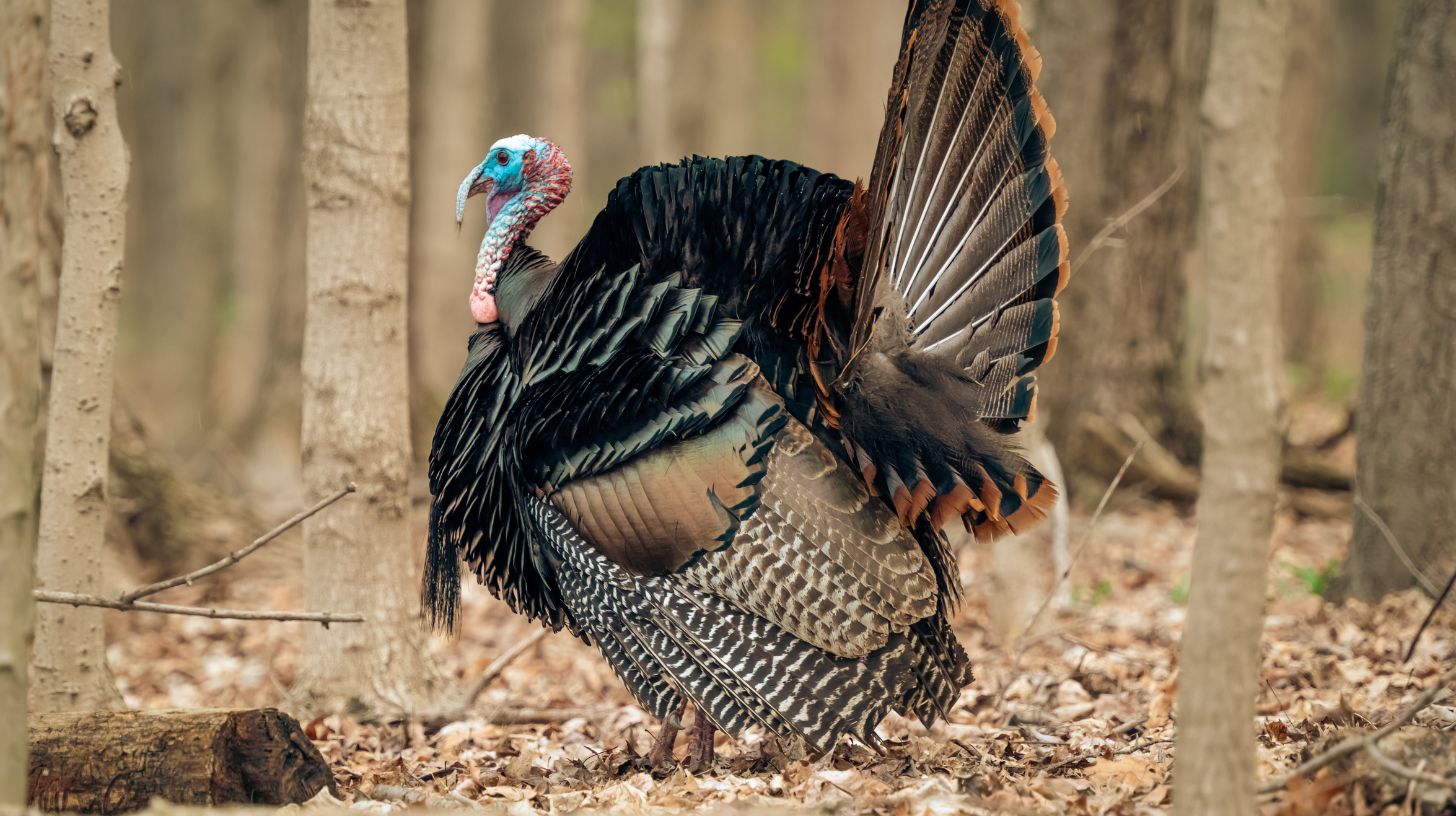Do Turkeys Have Ears? Discover Turkey Hearing Facts

Table of content:
Have you ever noticed small ear-like structures on a turkey’s head? While not large or prominent like a dog or human’s ears, turkeys do indeed have ears. Read on to learn all about turkey ears, how well turkeys can hear, and more turkey hearing facts.
What Do Turkey Ears Look Like?
To start with, what do turkey ears actually look like? At first glance, you may have a hard time spotting their ears among all the feathers and wattles. But turkeys do indeed have ears!
Turkey ears are small openings covered by feathers on either side of the head. The ear structure consists of a short ear canal and eardrum inside the head. There is no visible outer ear like the cup-shaped ears of mammals. Their small ear openings are all that is visible underneath the feathers.
Baby poults hatch out with ears proportional to their tiny head size. As the turkey matures, the head and ear grow to full adult size. But even on grown turkeys, their ears remain diminutive and not easy to see.
You may catch a glimpse of the ear opening on adult turkeys if you look closely underneath the feathers. But often even experienced turkey owners go years without noticing turkey ears due to their discreet size!
Turkey Ear Anatomy
Inside the small external opening is the ear canal, leading to the eardrum, or tympanum. This works just like a human eardrum, vibrating in response to sound waves.
Past the eardrum, turkeys have a specialized hearing apparatus common to all bird species. This includes a chamber called the cochlea, semicircular canals to sense balance and head position, and a short auditory nerve connecting to the brain.
The turkey ear may be small, but it is highly adapted and refined to detect a wide range of sound frequencies. Next, we’ll explore how well turkeys can actually hear.
Can Turkeys Hear Well?
Given their tiny ear size, you may wonder if turkeys have good hearing at all. But don’t underestimate them! Turkeys have a remarkably acute sense of hearing despite the small ears.
In fact, turkeys can perceive a wider range of frequencies and detect fainter sounds than human ears. Here are some key facts about turkey hearing abilities:
- Turkey hearing range – Turkeys can hear frequencies between about 125 Hz on the low end up to 9,000 Hz on the high end. For comparison, the human hearing range is typically 64 to 23,000 Hz. So turkeys miss out on some of the lowest bass tones but can hear higher pitched sounds.
- Hearing sensitivity – Turkeys have better absolute sensitivity, meaning they can detect very faint noises. Their hearing threshold is around -33 dB compared to the human threshold of 0 dB. Those extra -33 decibels make a big difference in how faint a sound they can pick up!
- Localizing sounds – Turkeys excel at detecting the source and direction of sounds. Their ears are specialized for localizing both low and high-pitched noises. This allows them to quickly pinpoint threats approaching from any direction.
- Hearing by frequency – Turkeys hear best between around 1,000 to 4,000 Hz. This frequency range aligns well with the calls of predators like coyotes and hawks that wild turkeys rely on hearing.
So while turkeys may have only diminutive ears, they use them very effectively. Their hearing adaptations are crucial for survival in the wild. Keep reading to learn more about how wild turkeys utilize their excellent hearing.
Do Wild Turkeys Have Ears? Hearing Importance for Wild Turkeys
As you may have guessed, wild turkeys absolutely have ears too. For wild turkeys, hearing is one of the most important senses for detecting and avoiding predators. Their ears are vital for survival in nature.
Wild turkeys face threats from many predators eager to grab them for dinner. Main predators of wild turkeys include:
- Coyotes
- Bobcats
- Hawks
- Falcons
- Owls
- Foxes
- Snakes
- Raccoons
- Opossums
And of course, humans also hunt wild turkeys. With all these predators after them, wild turkeys rely heavily on their hearing to stay aware and safe.
Their excellent high-frequency hearing picks up the sounds of rustling in bushes, flapping wings overhead, and small animal calls. Even though their ears are small, wild turkeys can accurately pinpoint these noises to know exactly where a predator is and how close.
Wild turkeys use calls amongst their flock as contact calls to reassemble if separated. Their hearing helps gather separated birds back together quickly for safety in numbers.
And male wild turkeys rely on hearing when performing their elaborate mating displays. The male turkeys make booming calls to show off to females and competing males in the area. Their keen ears ensure their calls are detected by potential mates.
So while inconspicuous, those small but powerful ears are essential tools for wild turkey survival and reproduction.
Turkey Hearing Development
Wild turkeys aren’t born with their astute hearing abilities. Their specialized ears and auditory systems take time to reach full function. Let’s look at how turkey hearing develops as they mature.
Turkey Poults Hearing Abilities
Turkey poults hatch out of the egg with their ears in an immature state. As they grow over the first weeks of life, their ears rapidly develop.
Newly hatched poults have some limited hearing immediately but cannot hear the full frequency range adult turkeys can detect. They also lack precision in locating sound sources at first.
But after about 4 weeks, a poult’s ears typically reach full maturity levels. At this point their hearing largely resembles an adult’s abilities. They can accurately pinpoint direction and make out the faintest noises.
How Turkey Ears Develop
What changes occur in turkey ears through development? The key aspects maturing include:
- The ear canal lengthens and fully opens
- The eardrum reaches adult size and thickness
- The inner ear bones fuse into place
- Development of fine hair cells in the cochlea for sound detection
- Auditory nerve myelination and improvements in signal transmission
As these anatomical features mature, the young turkey’s hearing steadily improves. Reaching each milestone results in better sound detection thresholds and localization.
Raising Healthy Poults
For poults being raised by humans, it’s important to support their ear development. Here are some tips:
- Provide a stress-free environment – stress can disrupt development
- Ensure poults cannot get cold or wet – this can lead to ear infections
- Feed a nutritious diet with vitamins A, D3, E for proper growth
- Avoid exposure to loud noises than can physically damage their delicate ears
Following these basic principles will set your poults up for proper ear maturation and lifelong excellent hearing.
Turkey Hearing Loss and Issues
Wild and domesticated turkeys rely heavily on their hearing to survive. But there are some issues that can impair or damage their hearing over time.
Common Causes of Turkey Hearing Loss
Hearing loss can result from:
- Age – Elderly turkeys may experience naturally declining hearing, just like elderly humans. High-pitched tones usually diminish first.
- Injuries – Trauma to the head can rupture the eardrum or damage the inner ear structures.
- Infections – Bacterial or viral ear infections can cause temporary or permanent hearing impairment.
- Loud noises – Exposure to extremely loud sounds like gunshots or fireworks near the ears can lead to noise-induced hearing loss. The delicate structures are damaged by the intensity.
- Toxins – Certain toxins like aminoglycoside antibiotics can harm the auditory nerves.
Signs of Hearing Loss in Turkeys
How do you know if your turkey may have impaired hearing? Signs include:
- Not responding when called or to other noises
- Acting startled when approached, since they cannot hear your footsteps
- Displaying signs of confusion and anxiety from inability to sense their surroundings
- Possible head tilting or eye positioning abnormalities
If you suspect hearing issues, consult your vet. They can examine the ears and run tests to diagnose any problems.
Caring for Partially Deaf Turkeys
Turkeys rely heavily on hearing to feel secure. But those with partial hearing loss can still live healthy, happy lives with some minor adjustments:
- Keep their environment consistent and predictable
- Gently tap them to get their attention before approaching or handling
- Use a flashlight to create visual signals to supplement impaired hearing
- Keep them closer to their flock for comfort and protection
With some simple adaptations, hearing-impaired turkeys can continue thriving even with their limitations.
Fascinating Turkey Hearing Facts
To wrap up, here are a few interesting turkey hearing facts:
- Newly hatched poults communicate with their mothers through high-pitched peeping, which their undeveloped ears can detect.
- Male turkeys have better high-frequency hearing than females, helping detect the peeps of poults.
- Domestic turkeys have slightly lesser hearing abilities than wild turkeys due to generations of protection from predators.
- Turkeys can detect sounds over distances up to a mile away on a calm day.
- Turkey ears contain anti-microbial oils to prevent infections in the warm, moist ear canal.
- The wattle dangling from a male turkey’s face amplifies soundwaves moving towards their ears.
Conclusion
While small and rather ordinary looking, turkey ears are surprisingly capable. From the excellent sensitivity of wild turkeys to the development of hearing in young poults, turkey ears and hearing are fascinating. An improved understanding of turkey ears can help us support the health and contentment of these unique birds.
So the next time you spot a turkey’s small ear opening hidden below its feathers, remember just how important that tiny ear is for the turkey’s experience of the world. These subtle but significant hearing tools equip turkeys to thrive from the prairies to farmyards across the land.
Welcome. I’m Adreena Shanum, the proud owner of this website, and I am incredibly passionate about animals, especially poultry. I founded adreenapets.com as a labor of love, stemming from my desire to share my knowledge and experiences with poultry enthusiasts worldwide.




